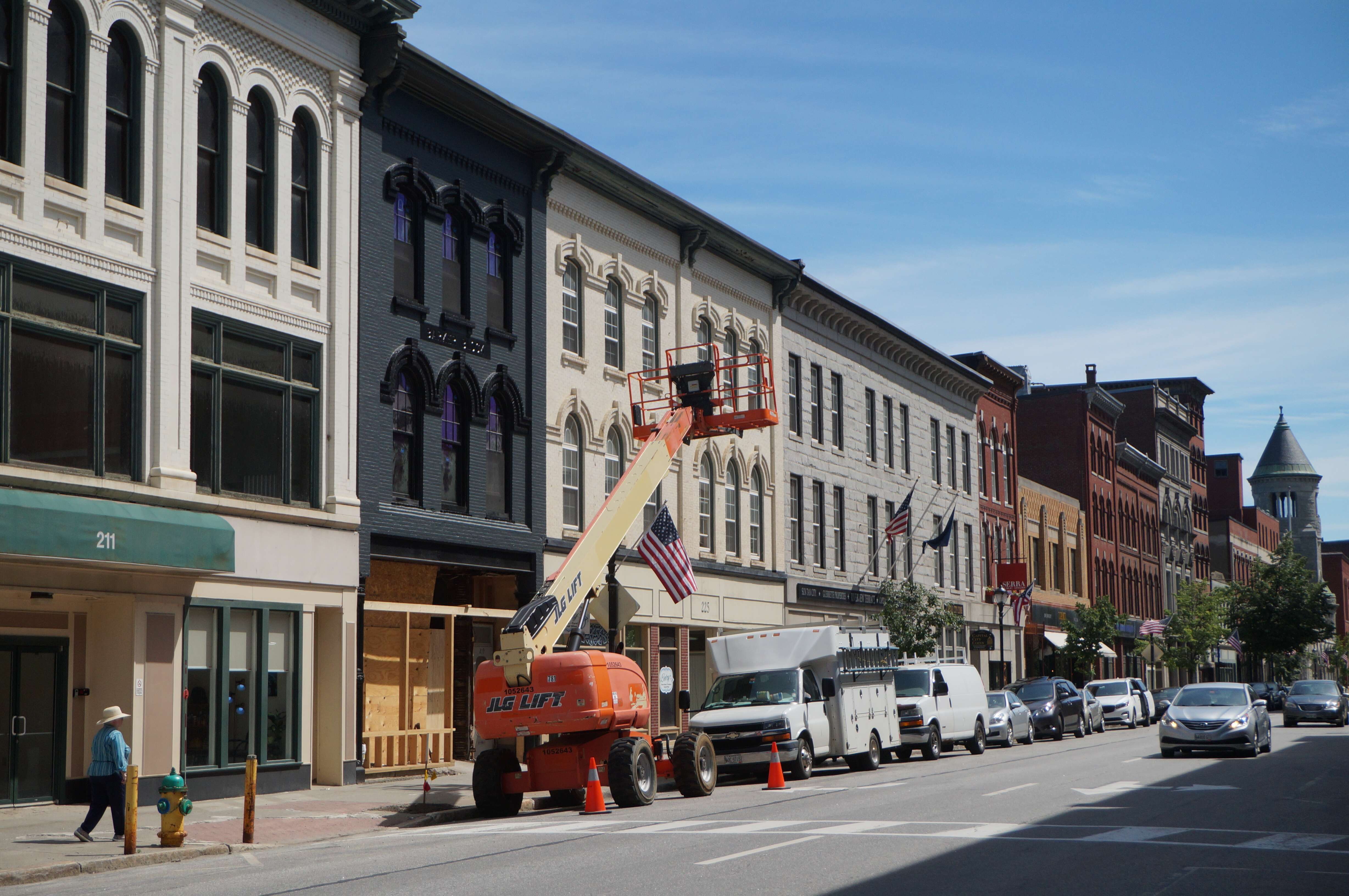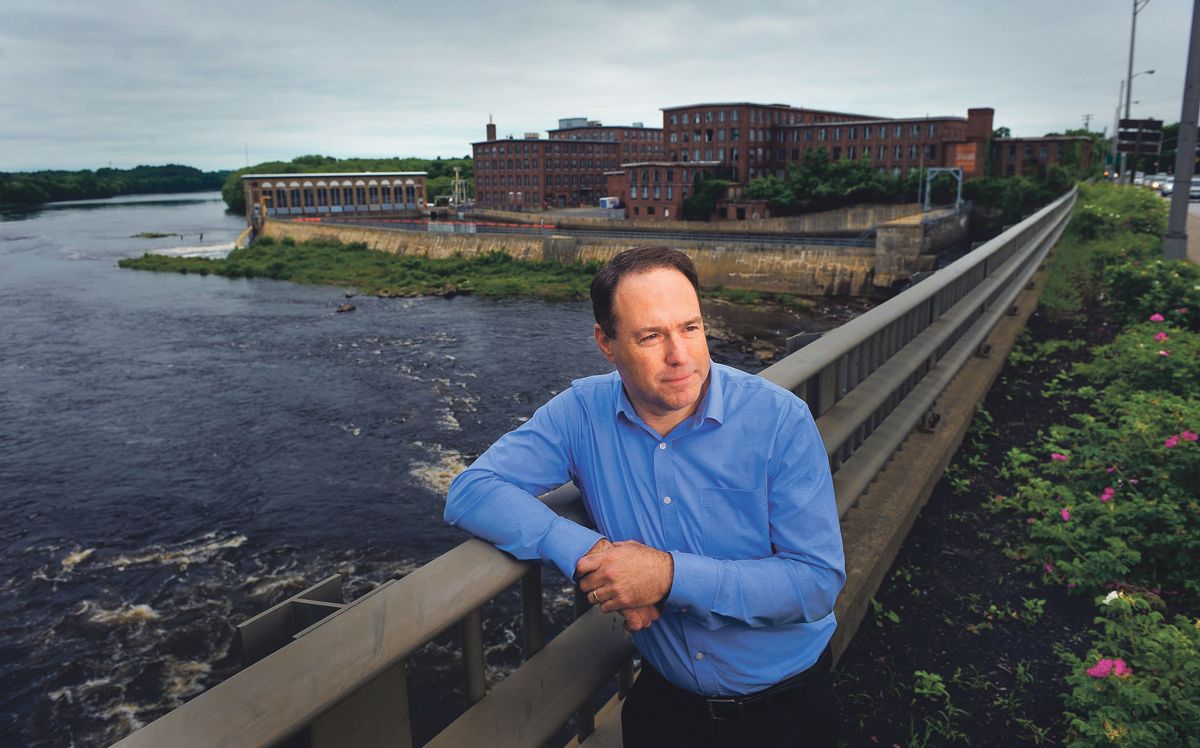
Watching the river flow: Along the Kennebec, developers and residents are returning to the river
 Photo / Fred Field
Anthony Gatti, a partner in North River Co., overlooking the Kennebec River, which is a visual focal point for the company’s Hathaway Creative Center and newly acquired Lockwood Mill.
Photo / Fred Field
Anthony Gatti, a partner in North River Co., overlooking the Kennebec River, which is a visual focal point for the company’s Hathaway Creative Center and newly acquired Lockwood Mill.
North River Co., the new owner of the Lockwood Mill in Waterville, considers the building a diamond in the rough — it’s worse for wear after years of vacancy, but it’s a classic 19th-century mill with soaring ceilings and windows, 3-foot brick walls and pine floors.
“They don’t build them like that anymore,” says North River partner Anthony Gatti as he sits in a conference room in the adjacent Hathaway Creative Center, also owned by North River.
When the property development company announced in June it had bought the 182,000-square foot building for $1.5 million, it touted another benefit — the building is on the Kennebec River.
The deal “represents the reinvigoration of Waterville’s riverside assets as the city returns to the river to enhance its quality of life,” the release said.
In the urban cores of Augusta and Waterville, the Kennebec River, once considered a polluted liability, is increasingly a key piece of downtown revitalization.
“We’re getting away from the ‘80s and ‘90s thinking,” says Glen Guerrette, of Guerrette Properties, which has developed apartments on the downtown riverfront in Augusta. “We have a different view of the river and downtown.”
Views ‘the best thing’
“We love mixing history with water,” says Gatti. Aside from the two Waterville mills, comprising 412,000 square feet, the New York-based company has been instrumental in several major projects in Maine.
North River owns the Pierce Atwood building on Portland’s waterfront, as well as the Fort Andross redeveloped mill on the Androscoggin River in Brunswick. Other holdings include One and Two Portland Square, which North River acquired in 2015 for $66 million, which was then the largest commercial real estate deal in Portland’s history, it was reported at the time.
Hathaway Creative Center had already been redeveloped when North River bought it in 2017 for $20.15 million. The Lockwood, also owned by Hathaway developer Paul Boghossian, “wasn’t in our initial plan,” says Gatti.
But the success of the Hathaway, coupled with Waterville’s downtown redevelopment surge, made the purchase attractive.
The Hathaway is tucked behind the Lockwood, which is front and center at a major intersection that includes U.S. Route 201.
It’s across the intersection from the Lockwood Hotel site, which Colby College will start construction on this year.
Gatti says the mill redevelopment, designed by Platz Associates in Auburn, will complement the Colby plans and also link the area of the city to downtown. There will likely be retail on the first floor, offices on the second and residential on the top two floors. The need for apartments in the city is acute.
Hathaway has 67 market-rate apartments, and Gatti says there hasn’t been a vacancy since North River bought it. “This community is very much in need of this style of apartments, and they want more.”
The L-shaped Lockwood not only faces downtown, but also the river.
“We feel the best thing we have going are the views,” he says. “They’re a major asset to this development.”

Inspired by the river
In Augusta, 20 miles down the river, Guerrette feels the same way.
Guerrette Properties, which own more than 450 rental units, bought 218 Water St. in downtown Augusta in 2003.
A few years later, the firm bought 221-239 Water St., four connected buildings, on the river side of the street. Most of the space was occupied by the accounting firm Macpage LLC. In 2013, the company, now Wiplfi | Macpage, moved into its own building.
The space left empty — wide open 8,000 to 9,000 square feet on each floor — was made for office use, and no one was looking for that kind of office space in downtown Augusta.
“We had to repurpose the building, it forced us to,” Guerrette says. “The view of the river inspired us.”
Now Riverview Terrace, the building has nine loft apartments, with more on the way. The apartments have 12-foot ceilings, exposed brick and killer views of the river.
Guerrette says they took a risk with high-end apartments — at the time, a two-bedroom apartment in Augusta rented for about $700 a month. It paid off. The first apartment went for $1,695.
There are also several office tenants, including Guerrette Properties, and the Oak Table & Bar restaurant recently opened on the ground floor.
Across the street, at 218 Water St., Guerrette’s first downtown building, there are 10 apartments. The first-floor retail space recently became home to Huiskamer Coffee Shop.
There are now more than 70 apartments occupied or under construction in the four-block downtown and counting, including in buildings owned by Tobias Parkhurst, a partner in Cushnoc Brewing, a brewery and tap room that opened in October 2017.
Other residential projects include the 23-apartment Vickery Block project by Andrew LeBlanc, 30 units in the former Odd Fellows Hall at 333 Water St. and 12 at 341 Water St., being developed by Matt and Heather Pouliot.
At the other end of Water Street, with a view of the river and Mill Park, site of the former Edwards Mill, Scarborough developer Matt Boulerice is redeveloping the former Kennebec Market building, including four apartments.
“We’ve been saying it for years, and it’s come true,” says Keith Luke, Augusta’s deputy development director. “Upper-floor development is driving ground floor retail and food service.”
Impact being felt
The river has been working for the region’s economy for centuries, since the Abanaki used it as their main transport route. Since then, it has powered mills from its headwaters at Moosehead Lake down the 170 miles to Bath and the Atlantic.
It was a working river, a place to dump waste, both from the mills and the communities along its banks. The dirtier it became, only those guiding the log drives that clogged it every summer ventured in. There were few fish or other river habitat. Few boated on it. No one swam in it.
That began to change in 1972 with the Clean Water Act, which was championed by U.S. Sen. Ed Muskie, who grew up in Rumford on the Andrsocoggin. The last Kennebec log drive was in 1976, and there were new regulations for river valley municipalities and businesses.
In 1999 Augusta’s Edwards Dam, which since 1837 had prevented fish from traveling upriver, was removed. It was hailed not only as an environmental necessity, but an economic one.
Today, the river is “critically important” to economic development, says Garvan Donegan, director of economic develoment and planning for the Central Maine Growth Council.
The impact is different on a case-by-case basis, but substantial. “I’ve seen it with the Lockwood development, and in a very concrete way with the Riverwalk,” he says.
Waterville’s RiverWalk, on a lot that’s been vacant for 50 years, was developed over the past two years as a spark to further development of the 20-acre site. The city added utilities infrastructure over the years, but when requests for proposals went out, developers didn’t bite.
There was a different response when requests for proposals for a mixed-use building went out this spring. The city is considering several bids, Donegan says.
More rural communities along the river are also considering ways to take advantage of it.
In Fairfield, they’re discussing the possibility of housing in the pastoral Hinckley section of town, and other towns are discussing looking at aquaculture development, Donegan says.
The recreational activity associated with the river, including trails, fishing, boating and more, adds value to development and commerce. “Combined with the historic downtowns along the river, it taps into the place-based economy,” he says.
He says it’s a brand identity the region is learning to embrace.

Slow and steady
There are still major sites that have yet to be developed.
“We turned our backs on the river for 200 years,” Luke, of Augusta, says. “It takes time to turn that around.”
The historic Kennebec Arsenal, vacant for years, was bought by North Carolina developer Tom Niemann in 2007, but the recession hit, and plans for a mixed-use development haven’t materialized.
A mile upriver, the former Statler Tissue site, now Kennebec Locke, has the foundation for development, but the city has yet to get any interest.
Development along the river is “slow and steady,” says Chris Paszyc, a broker with The Boulos Co. “I would not say it’s a gold rush.”
River development has caught on in downtowns faster than in rural areas. “The baby boomers and millennials are gravitating to the urban centers, there’s more demand for eateries, and establishments that support their lifestyles,” Paszyc says.
The river, too, can still be barrier to development.
“One of the issues that developers have to grapple with is being in close proximity to the river presents challenges,” including flood plain issues and difficulties of renovating old or historic properties, he says.
Paszyc also says municipalities should be proactive. “The key with redevelopment on the river is getting the zoning and infrastructure in place, so a developer doesn’t have to start from scratch,” he says.
‘Opportunities we can’t even imagine’
Luke says development will come to the Kennebec Locke site, which is in a residential area, across the river from downtown. The city acquired the site in 2011, razed the buildings and cleaned up toxins left over from more than a century of making paper.
The 29-unit Maple Street apartments, built by the Augusta Housing Authority on the site, is almost finished. “That’s a significant project,” Luke says.
Initial concerns from area residents about traffic and congestion helped the city learn how to approach development for the rest of the 17-acre site, which has been targeted for office or other nonresidential uses.
That development won’t be in the immediate future. Luke says high construction costs are one barrier to development, something that’s not unique to Kennebec Locke. The city is working on it, and he believes issues will work themselves out, because the site is attractive.
“The river is a tremendous asset to that location,” he says. “Opportunities we can’t even imagine now will manifest.”
Turning around
Front Street, which runs behind Augusta’s downtown along the river, used to be a gritty parking lot with the unadorned backs of downtowns building looming over it. No one spent much time there.
On a recent sunny day, a kayaker paddled aside a family of ducks. Nearby, a crew on a speedboat cheered as a sturgeon sprang from the water, did a twist, then disappeared back under the blue surface. Across the river, at the East Side Boat Landing, half a dozen people fished.
A group sipping drinks from the terrace of a Water Street apartment, which overlooks a park-like Front Street with grass, trees and a walking path, took in the scene.
Developers and planners frequently use the phrase “we turned our backs on the river.” Now, they say, that’s changing.
Luke, an amateur photographer, has half a dozen photos he’s taken of sturgeon leaping from the water. He says he took the best one while enjoying a beer at Cushnoc Brewing’s riverfront tables.
Upriver, RiverWalk, Donegan says, is a metaphor for what’s happened along the Kennebec. “It was a former mill site, then a brownfield,” he says. “Now people realize it’s a great place.”
People in his office head to the river to fish at lunchtime. “They’re pulling fish, the sturgeon are jumping, the bald eagles are flying overhead,” he says. “As a place-based economy, with the waterfront being a catalyst, it’s a really wonderful model.”










0 Comments